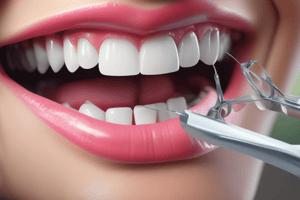Podcast
Questions and Answers
What is the function of support in a removable partial denture?
What is the function of support in a removable partial denture?
- Provides firmness and steadiness to the denture
- Balances the forces acting on different parts of the denture
- Resists movement of the prosthesis toward the edentulous ridge (correct)
- Resists movement of the prosthesis away from the edentulous ridge
What is the role of retention in a removable partial denture?
What is the role of retention in a removable partial denture?
- Provides firmness and steadiness to the denture
- Resists movement of the prosthesis away from the edentulous ridge (correct)
- Resists movement of the prosthesis toward the edentulous ridge
- Balances the forces acting on different parts of the denture
What does stability refer to in a removable partial denture?
What does stability refer to in a removable partial denture?
- Firmly holds the denture in place during function (correct)
- Resists movement of the prosthesis away from the edentulous ridge
- Provides firmness and steadiness to the denture
- Resists movement of the prosthesis toward the edentulous ridge
What is reciprocation in a removable partial denture?
What is reciprocation in a removable partial denture?
What is cross-tooth stabilization in a removable partial denture?
What is cross-tooth stabilization in a removable partial denture?
Flashcards are hidden until you start studying
Study Notes
Functions of Support in Removable Partial Dentures
- Provides vertical support to distribute occlusal forces evenly across the residual ridge.
- Prevents movement of the denture during functional activities such as chewing and speaking.
- Maintains comfort for the patient by reducing tissue stress through appropriate support mechanisms.
Role of Retention in Removable Partial Dentures
- Ensures the denture remains securely in place by resisting dislodging forces during function.
- Achieved through a combination of clasp design, friction, and the physical contours of the supporting teeth and tissues.
- Important for patient confidence and comfort, allowing for normal function without fear of displacement.
Stability in Removable Partial Dentures
- Refers to the ability of the denture to resist horizontal or rotational forces during function.
- Stability is dependent on proper fit, well-designed connectors, and strategic placement of clasps.
- Essential for maintaining the position of the denture and preventing discomfort or irritation to oral tissues.
Reciprocation in Removable Partial Dentures
- Involves the design elements that counteract the movement of retainers during function.
- Provides resistance to lateral forces exerted on the supporting teeth from the clasp arms.
- Crucial for preventing tilting of the abutment tooth and enhancing the overall function and fit of the denture.
Cross-Tooth Stabilization in Removable Partial Dentures
- Describes the method of stabilizing a denture by connecting clasps or elements associated with opposing sides of the dental arch.
- Helps distribute forces evenly across the arch, preventing undue stress on any single tooth or area.
- Enhances the overall stability and effectiveness of the removable partial denture during function.
Studying That Suits You
Use AI to generate personalized quizzes and flashcards to suit your learning preferences.





